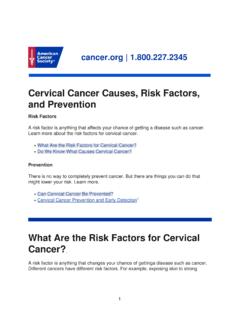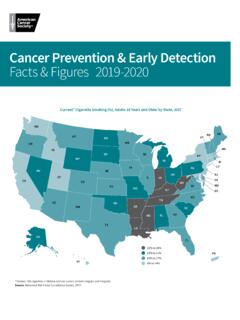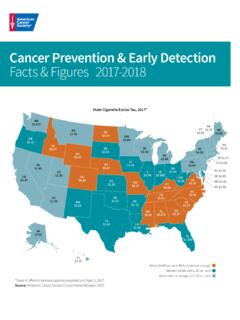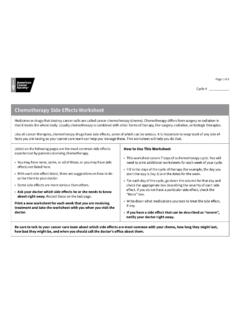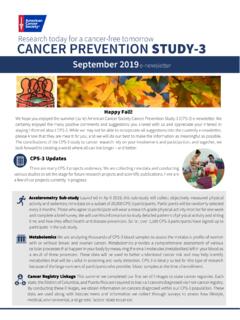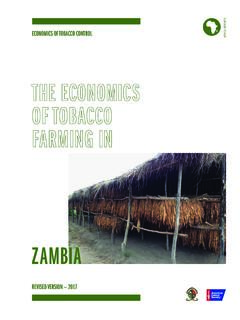Transcription of Lung Cancer Fact Sheet - American Cancer Society
1 Lung Cancer fact SheetLung Cancer in the US1 Lung Cancer is the second most common Cancer and the leading cause of Cancer death for both men and women. Lung Cancer is most often caused by exposure to cigarette smoke and other airborne chemicals. Types of Lung Cancer 2 There are 2 main types of lung Cancer non-small cell lung Cancer (NSCLC) and small cell lung (SCLC) Cancer . NSCLC accounts for about 80%-85% of lung Cancer and includes adenocarcinoma, squamous cell carcinoma, and large cell carcinoma. These subtypes have similar treatments and prognoses. SCLC accounts for about 10%-15% of all lung cancers and tends to metastasize faster than NSCLC. About 70% of people with SCLC present with metastasis at the time of diagnosis. Risk Factors1, 2 Tobacco use Smoking is the leading risk factor of lung Cancer , but often interacts with other factors.
2 About 80% of lung Cancer deaths are caused by smoking. For people who do smoke, a higher pack-year history can lead to an increased risk of developing lung Cancer . SCLC rarely occurs in people who have never smoked. Secondhand smoke For people who have never smoked, exposure to secondhand smoke (SHS) can increase their risk for lung Exposure to radon is the second-leading cause of lung Cancer . Radon is found at high levels in some Exposure to asbestos is another risk factor for lung Cancer , specifically mesothelioma. Exposure may occur in mines, mills, textile plants, places where insulation is used, and shipyards. People exposed to large amounts of asbestos have a greater risk of developing | carcinogens Exposure to air pollutants and other chemicals and substances , including arsenic, vinyl chloride, coal products, diesel exhaust, and radioactive ores like uranium, has been shown to increase lung Cancer risk.
3 Personal or family history People with a personal history of lung Cancer have a higher risk of developing another lung Cancer . First-degree relatives of people who have had lung Cancer may have a slightly higher risk of lung 2, 3, 4 Lung Cancer screening may be beneficial for certain patients at higher risk who are not exhibiting signs and symptoms. The American Cancer Society recommends yearly lung Cancer screening with a low-dose CT (LDCT) scan for certain people at higher risk for lung Cancer who meet all of the following criteria: 55 to 74 years old and in reasonably good health Currently smoke or have quit smoking in the past 15 years Have at least a 30 pack-year smoking history Receive counseling for cessation, if they currently smoke Have been told about the possible benefits, limits, and risks of screening with LDCT scans Have a facility available with experience in lung Cancer screening and treatment Signs and Symptoms2 Signs and symptoms of lung Cancer include persistent cough, blood-streaked sputum, chest pain, voice change, shortness of breath, and recurrent pneumonia or bronchitis.
4 Some people may present with Horner syndrome, superior vena cava syndrome (SVC), or a paraneoplastic syndrome. Lung Cancer in the US:2020 estimates1, 4 New cases: 228,820 (116,300 in men and 112,520 in women) Deaths: 135,720 (72,500 in men and 63,220 in women) 5 -year relative survival rate for localized stage (NSCLC): 61% 5-year relative survival rate for all stages combined (NSCLC): 24% 5 -year relative survival rate for localized stage (SCLC): 27% 5-year relative survival rate for all stages combined (SCLC): 6%Prevention1, 2, 3, 4 Not all lung cancers can be prevented. Patient education and guidance related to risk factors can help reduce the risk for some people. Avoiding or quitting tobacco can significantly reduce a person s risk of developing lung Cancer .
5 Exposure to SHS should also be avoided. Identifying people at risk for exposure to carcinogens, such as radon, asbestos, phosphate fertilizers, and other harmful chemicals at home or work, can lead to interventions that help prevent or minimize exposure. Monitoring indoor radon levels at home and getting homes treated if needed are additional strategies. Completing a periodic assessment for risk factors, following recommended screening guidelines, and providing health education to patients who may be at higher risk for lung Cancer should be a regular part of care. Treatment 2, 5 NSCLC and SCLC have different treatment recommendations. Treatment options are based on the tumor subtype, stage, and molecular characteristics, along with patient comorbidities. Surgery, radiation therapy, chemotherapy, targeted therapy, and immunotherapy drugs, either in combination or alone, are common treatments that might be used.
6 You can learn more about treatment options for the different types of lung Cancer at Quality of Life 2, 6, 7 Common issues affecting quality of life for people with lung Cancer include the effects of Cancer and its treatment, fear of recurrence, activity intolerance, chronic and/or acute pain, weakness, anorexia, cachexia, dyspnea, anemia, and stigma and guilt associated with a lung Cancer diagnosis and its low survival rate can cause stress, worry, or guilt that affects quality of life. Patients may feel (or be made to feel) they somehow delayed screening or treatment, ignored symptoms, or did things that may have caused the Cancer . A Cancer diagnosis can profoundly impact quality of life. Clinicians should assess for any physical, social, psychological, spiritual, and financial issues.
7 Integrating palliative care can help manage symptoms, address issues, and improve quality of life. It can be offered at any time from the point of diagnosis until the end of life. Throughout a patient s Cancer journey, it s very important for clinicians to share information and coordinate care to ensure surveillance is American Cancer Society . Cancer Facts & Figures 2020. Atlanta. American Cancer Society ; 2020. Accessed at on January 31, 2020. 2. American Cancer Society . Lung Cancer . 2019. Accessed at on January 31, Smith RA, Andrews KS, Brooks D, et. al. Cancer screening in the United States, 2019: A review of current American Cancer Society guidelines and current issues in Cancer screening. CA: A Cancer Journal for Clinicians. 2019;69 American Cancer Society .
8 Cancer Prevention and Early Detection Facts & Figures 2019-2020. Atlanta. American Cancer Society ; 2019. Accessed at on January 31, National Comprehensive Cancer Network. NCCN Clinical Practice Guidelines in Oncology: Non-Small Cell Lung Cancer . Accessed at on January 31, National Comprehensive Cancer Network. NCCN Clinical Practice Guidelines in Oncology: Small Cell Lung Cancer . Accessed at physician_gls/ on January 31, Web LA, McDonnell KK, Adams SA, et al. Exploring Stigma among lung Cancer survivors: a scoping literature review. Oncology Nurse Forum. 2019; 46(4): Brown, CG, ed. A Guide to Oncology Symptom Management. 2nd ed. Pittsburgh, PA: Oncology Nursing Society 2015. 2020, American Cancer Society , Rev. 1/20 Models used for illustrative purposes only.
